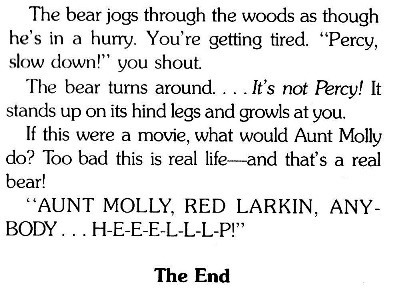So William Tapley’s horrible Romney song earned him a place on Anderson Cooper’s ridiculist.
Here’s Cooper putting him on the list.
Here’s Tapley’s response.
Fun times.
So William Tapley’s horrible Romney song earned him a place on Anderson Cooper’s ridiculist.
Here’s Cooper putting him on the list.
Here’s Tapley’s response.
Fun times.
Amazing. I can’t wait to try this.
You can even (allegedly) use them to season your food.
From Squidoo, via Lifehacker
This is brilliant. This gun, called the BugASalt, kills insects with just a pinch of salt. You can pledge some funds, safe in the knowledge its already hit its target, to grab yours today. Sure beats swatting.
Arthur sent me this on Facebook.
Ted Turner is a billionaire, famous for inventing Captain Planet, and perhaps less notably, CNN.
When he was young he decided to study the Classics at university. His father, Billboard mogul, was less than impressed and wrote him this letter, now featured on Letters of Note.
Here are some highlights.
I am appalled, even horrified, that you have adopted Classics as a major. As a matter of fact, I almost puked on the way home today. I suppose that I am old-fashioned enough to believe that the purpose of an education is to enable one to develop a community of interest with his fellow men, to learn to know them, and to learn how to get along with them. In order to do this, of course, he must learn what motivates them, and how to impel them to be pleased with his objectives and desires.
Ted Sr thinks the Classics are interesting, but largely useless.
I am a practical man, and for the life of me I cannot possibly understand why you should wish to speak Greek. With whom will you communicate in Greek? I have read, in recent years, the deliberations of Plato and Aristotle, and was interested to learn that the old bastards had minds which worked very similarly to the way our minds work today. I was amazed that they had so much time for deliberating and thinking, and was interested in the kind of civilization that would permit such useless deliberation. Then I got to thinking that it wasn’t so amazing—after all they thought like we did because my Hereford cows today are very similar to those ten or twenty generations ago…
…I suppose everybody has to be a snob of some sort, and I suppose you will feel that you are distinguishing yourself from the herd by becoming a Classical snob. I can see you drifting into a bar, belting down a few, turning around to the guy on the stool next to you—a contemporary billboard baron form Podunk, Iowa—and saying, “Well, what do you think about old Leonidas?” Your friend, the billboard baron, will turn to you and say, “Leonidas who?” You will turn to him and say, “Why Leonidas, the prominent Greek of the Twelfth Century.” He will, in turn, say to you, “Well, who in the hell was he?” You will say, “Oh, you don’t know about Leonidas?” and dismiss him, and not discuss anything else with him the rest of the evening. He will feel that he is a clodhopper from Podunk, Iowa. I suppose this will make you both happy, and as a result of it, you will wind up buying his billboard plant…
…”It isn’t really important what I think. It’s important what you wish to do with your life. I just wish I could feel that the influence of those oddball professors and the ivory towers were developing you into the kind of a man we can both be proud of. I am quite sure that we both will be pleased and delighted when I introduce you to some friend of mine and say, “This is my son. He speaks Greek.””
The bold bit pretty much sums up my thinking regarding the study of Greek. Though it turns out that Ted Jr was probably right. History favours the brave.
This video made me decide that our turtles are definitely live in a tank turtles, and not walking on the road, fighting crime, turtles.
Here you go. A single serving tumblr celebrating the unhappy ending pages of Choose Your Own Adventure books. You Chose Wrong…

from Choose Your Own Adventure #19: Secret of the Pyramids, 1983

from Choose Your Own Adventure for Younger Readers #41: The Movie Mystery, 1987
The running water is back. The wacky rhymes are back. The obscure metre and bad midi sounds are back. Third Eagle is back.
I love that he ends with two thumbs up.
It seems obvious that you can’t do this. XKCD does the math (or physics) to demonstrate that not only is it impossible, it’s also fatal for pitcher, batter, and probably the entire city…

“After about 70 nanoseconds the ball arrives at home plate. The batter hasn’t even seen the pitcher let go of the ball, since the light carrying that information arrives at about the same time the ball does. Collisions with the air have eaten the ball away almost completely, and it is now a bullet-shaped cloud of expanding plasma (mainly carbon, oxygen, hydrogen, and nitrogen) ramming into the air and triggering more fusion as it goes. The shell of x-rays hits the batter first, and a handful of nanoseconds later the debris cloud hits.”

It’s not all bad news though. The batter gets on base.
A careful reading of official Major League Baseball Rule 6.08(b) suggests that in this situation, the batter would be considered “hit by pitch”, and would be eligible to advance to first base.
I love this stuff. The XKCD “What If” blog is tackling similar questions on a weekly basis. Like trying to figure out how much power Yoda could generate via the Force.
This Flickr set of Reformation images reconstructed using Lego comes a semester too late for me… but given that I think Luther was all for communicating truth using every available medium, I reckon he’d love this.


This is a nice little addition to these book reviews… if we want cut through for the gospel online, in all of these channels, we need to remember we’re competing with a lot of white noise as we try to get the signal out. This is what gets produced and uploaded in the space of a minute on the world wide web…
